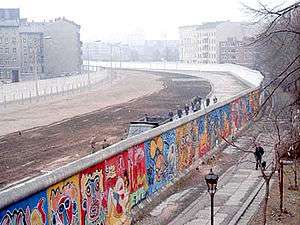Czesław Kukuczka
Czesław Kukuczka (July 23, 1935, Kamienica, Poland – March 29, 1974 Berlin, Germany, was a Polish man killed trying to cross the Berlin Wall.
Biography
Czesław Kukuczka was born in Kamienica, within Limanowa County in southern Poland, and grew up there. As a young boy, the local magazine “Gorczańskie Wieści" mentioned him as "the most active of the hotheads - young, full of ideas, and capable of dedication." At the age of 17, Kukuczka was recruited to participate in the construction of Nowa Huta, a socialist working city on the eastern outskirts of Krakow. But he returns home soon, departing Nowa Huta in bad standing, disillusioned with his work there. A year later, at 18 years old, he is found guilty of embezzlement, and sentenced to two and a half years in prison in Nowy Sącz and Jaworzno. He was released after one year on parole, soon married, and would father three children. Subsequent work would include construction, followed by working as a firefighter for the fire department in Jaworzno. On Sunday, March 3, 1974, Kukuczka disappears without a trace; he does not appear at his place of work, and was not seen again until March 29, 1974, in East Berlin.[1][2][3]
Death
On Friday, March 29, 1974, at 12:30 PM, Kukuczka arrived at the Polish Embassy in East Berlin, claiming to have an important message, and is admitted to the embassy without further control. He would be hosted by Colonel Maksymilian Karnowski, a member of the Berlin operational group of the Polish Ministry of the Interior (MSW), and an employee named Olszewski. He demands that he be allowed to cross into West Berlin at 3:00 PM, via the border crossing and international train station at Friedrichstraße, and threatens to detonate a bomb that he was carrying with him, with the detonating noose connected to his left hand. He claimed that if his demands were not met, because of an accomplice he claimed to have had in East Berlin, that the Polish Information and Cultural Center on Karl-Liebknecht-Straße would also be bombed, and the events would be reported about in the western world, because of an accomplice he claimed to also have in West Berlin. Further in his conversation, he indicated wishing to immigrate to the United States, where he had aunts; according to documents found on his person, their address was in the city of Hollywood, Florida. He was counting on Polish embassy personnel to create the necessary travel documents, so he could leave East Berlin. Which they provide him with.[1][2][3]
Kukuczka departed the Polish Embassy at 2:40 PM with the necessary documents, and was transported to Bahnhof Friedrichstraße by an awaiting Stasi car. He disembarked at the train station, used the rest room, then attempted to make his way through the border security. On this day, at about this time West German students vising from Bad Hersfeld would report to the Polizei back in West Berlin that they witnessed a shabbily dress man, who passed them unsuspectingly, and was then shot in the back by a civilian wearing a dark coat and tinted sunglasses, just two meters from his victim. Seriously injured but not yet dead, Kukuczka was not transported to the nearest hospital (including the nearby Krankenhaus der Volkspolizei, now the Bundeswehr Krankenhaus, where most Berlin Wall victims were taken), but to the hospital within the Stasi Prison in Hohenschönhausen, 10 kilometers away. By 6:30 PM, he was dead of numerous internal injuries.[1][2][3]
Kukuczka was one of least 139 victims mortally injured at the Berlin Wall. He was one of only two known foreign nationals (non-German descent and non-German resident) casualty of the Berlin Wall. Franciszek Piesik was the other, also Polish. Cengaver Katranci and Çetin Mert were of Turkish descent, and Giuseppe Savoca was of Italian descent, but all three were West Berlin residents. Other Berlin Wall victims came from German territory which is today Poland (i.e. Ida Siekmann, Egon Schultz), but they were all of German descent. Kukuczka was of Polish descent.[1][2][3]
Burial
Kukuczka’s widow Emilia was presented with an urn containing his cremains on 24 May 1974, along with a package containing personal effects from her deceased husband, and a death certificate. This was all presented by the district prosecutor. The next day, the mayor of the Kamienica village reported that that a church burial had taken place in the closest family circle, and full details regarding his death, to include the fake bomb and the visit to the embassy, were not made known to the family or local residents until after the Berlin Wall fell.[1][2][3]
References
- 1 2 3 4 5 Biography at Chronik der Mauer.de
- 1 2 3 4 5 Biography at Gedenkstätte Berliner Mauer.de
- 1 2 3 4 5 Grenzübergang Friedrichstraße Forscher rekonstruieren Fall um Mauertoten (Researchers at the former Friedrichstraße border crossing reconstruct the case around masonry), Berliner Zeitung Onliine, November 6, 2016 (German)
